Front LINCOLN MKX 2016 Owners Manual
[x] Cancel search | Manufacturer: LINCOLN, Model Year: 2016, Model line: MKX, Model: LINCOLN MKX 2016Pages: 563, PDF Size: 4.96 MB
Page 4 of 563
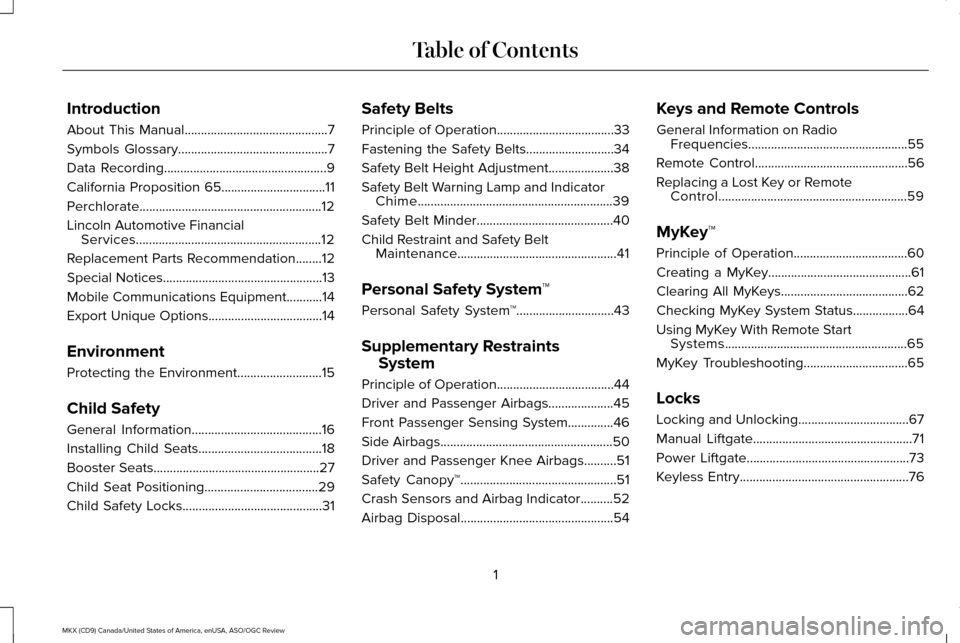
Introduction
About This Manual............................................7
Symbols Glossary
..............................................7
Data Recording
..................................................9
California Proposition 65................................11
Perchlorate........................................................12
Lincoln Automotive Financial Services
.........................................................12
Replacement Parts Recommendation........12
Special Notices
.................................................13
Mobile Communications Equipment
...........14
Export Unique Options...................................14
Environment
Protecting the Environment
..........................15
Child Safety
General Information........................................16
Installing Child Seats......................................18
Booster Seats
...................................................27
Child Seat Positioning...................................29
Child Safety Locks...........................................31 Safety Belts
Principle of Operation
....................................33
Fastening the Safety Belts...........................34
Safety Belt Height Adjustment....................38
Safety Belt Warning Lamp and Indicator Chime
............................................................39
Safety Belt Minder..........................................40
Child Restraint and Safety Belt Maintenance.................................................41
Personal Safety System ™
Personal Safety System ™
..............................43
Supplementary Restraints System
Principle of Operation
....................................44
Driver and Passenger Airbags....................45
Front Passenger Sensing System
..............46
Side Airbags
.....................................................50
Driver and Passenger Knee Airbags..........51
Safety Canopy™................................................51
Crash Sensors and Airbag Indicator
..........52
Airbag Disposal
...............................................54 Keys and Remote Controls
General Information on Radio
Frequencies.................................................55
Remote Control...............................................56
Replacing a Lost Key or Remote Control..........................................................59
MyKey™
Principle of Operation...................................60
Creating a MyKey............................................61
Clearing All MyKeys
.......................................62
Checking MyKey System Status.................64
Using MyKey With Remote Start Systems........................................................65
MyKey Troubleshooting................................65
Locks
Locking and Unlocking..................................67
Manual Liftgate
.................................................71
Power Liftgate
..................................................73
Keyless Entry
....................................................76
1
MKX (CD9) Canada/United States of America, enUSA, ASO/OGC Review Table of Contents
Page 6 of 563
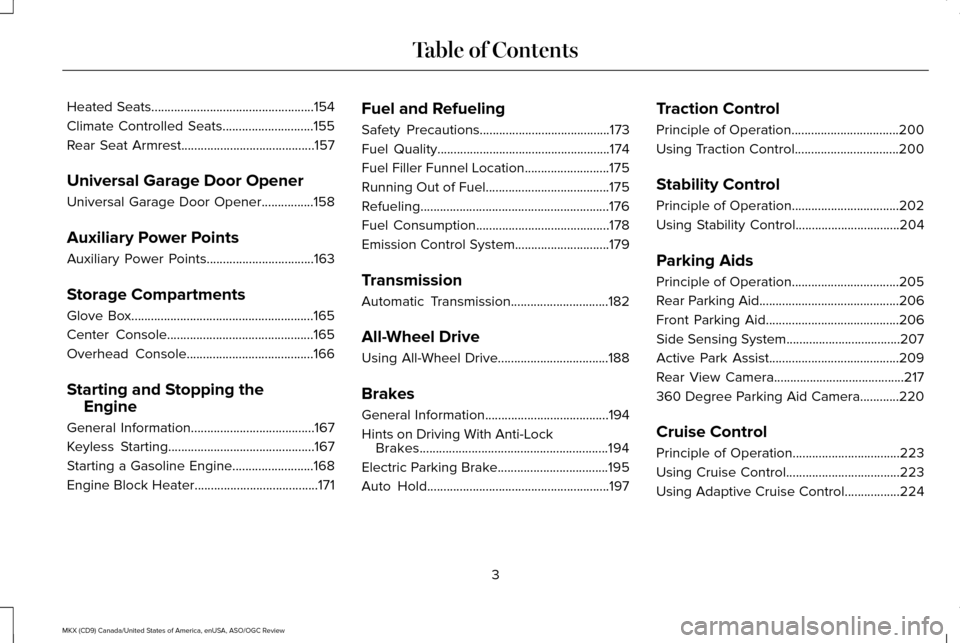
Heated Seats..................................................154
Climate Controlled Seats............................155
Rear Seat Armrest.........................................157
Universal Garage Door Opener
Universal Garage Door Opener................158
Auxiliary Power Points
Auxiliary Power Points.................................163
Storage Compartments
Glove Box
........................................................165
Center Console
.............................................165
Overhead Console.......................................166
Starting and Stopping the Engine
General Information
......................................167
Keyless Starting.............................................167
Starting a Gasoline Engine.........................168
Engine Block Heater
......................................171 Fuel and Refueling
Safety Precautions........................................173
Fuel Quality
.....................................................174
Fuel Filler Funnel Location..........................175
Running Out of Fuel
......................................175
Refueling..........................................................176
Fuel Consumption
.........................................178
Emission Control System.............................179
Transmission
Automatic Transmission
..............................182
All-Wheel Drive
Using All-Wheel Drive..................................188
Brakes
General Information
......................................194
Hints on Driving With Anti-Lock Brakes..........................................................194
Electric Parking Brake..................................195
Auto Hold
........................................................197 Traction Control
Principle of Operation.................................200
Using Traction Control................................200
Stability Control
Principle of Operation.................................202
Using Stability Control................................204
Parking Aids
Principle of Operation.................................205
Rear Parking Aid...........................................206
Front Parking Aid
.........................................206
Side Sensing System...................................207
Active Park Assist........................................209
Rear View Camera
........................................217
360 Degree Parking Aid Camera............220
Cruise Control
Principle of Operation.................................223
Using Cruise Control...................................223
Using Adaptive Cruise Control
.................224
3
MKX (CD9) Canada/United States of America, enUSA, ASO/OGC Review Table of Contents
Page 11 of 563
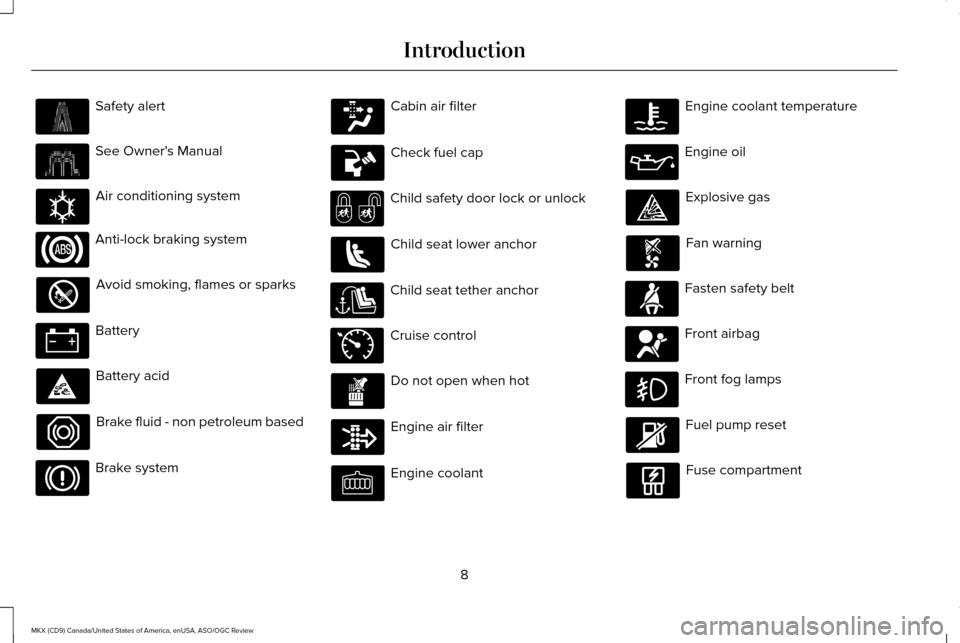
Safety alert
See Owner's Manual
Air conditioning system
Anti-lock braking system
Avoid smoking, flames or sparks
Battery
Battery acid
Brake fluid - non petroleum based
Brake system Cabin air filter
Check fuel cap
Child safety door lock or unlock
Child seat lower anchor
Child seat tether anchor
Cruise control
Do not open when hot
Engine air filter
Engine coolant Engine coolant temperature
Engine oil
Explosive gas
Fan warning
Fasten safety belt
Front airbag
Front fog lamps
Fuel pump reset
Fuse compartment
8
MKX (CD9) Canada/United States of America, enUSA, ASO/OGC Review Introduction E162384 E71340
Page 12 of 563
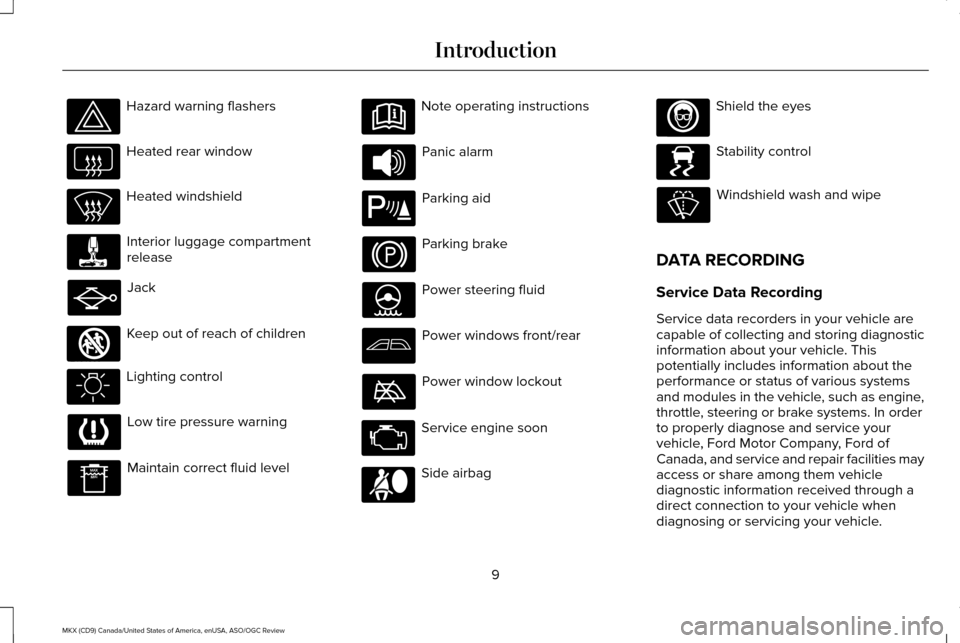
Hazard warning flashers
Heated rear window
Heated windshield
Interior luggage compartment
release
Jack
Keep out of reach of children
Lighting control
Low tire pressure warning
Maintain correct fluid level Note operating instructions
Panic alarm
Parking aid
Parking brake
Power steering fluid
Power windows front/rear
Power window lockout
Service engine soon
Side airbag Shield the eyes
Stability control
Windshield wash and wipe
DATA RECORDING
Service Data Recording
Service data recorders in your vehicle are
capable of collecting and storing diagnostic
information about your vehicle. This
potentially includes information about the
performance or status of various systems
and modules in the vehicle, such as engine,
throttle, steering or brake systems. In order
to properly diagnose and service your
vehicle, Ford Motor Company, Ford of
Canada, and service and repair facilities may
access or share among them vehicle
diagnostic information received through a
direct connection to your vehicle when
diagnosing or servicing your vehicle.
9
MKX (CD9) Canada/United States of America, enUSA, ASO/OGC Review Introduction E161353 E139213 E167012 E138639
Page 16 of 563
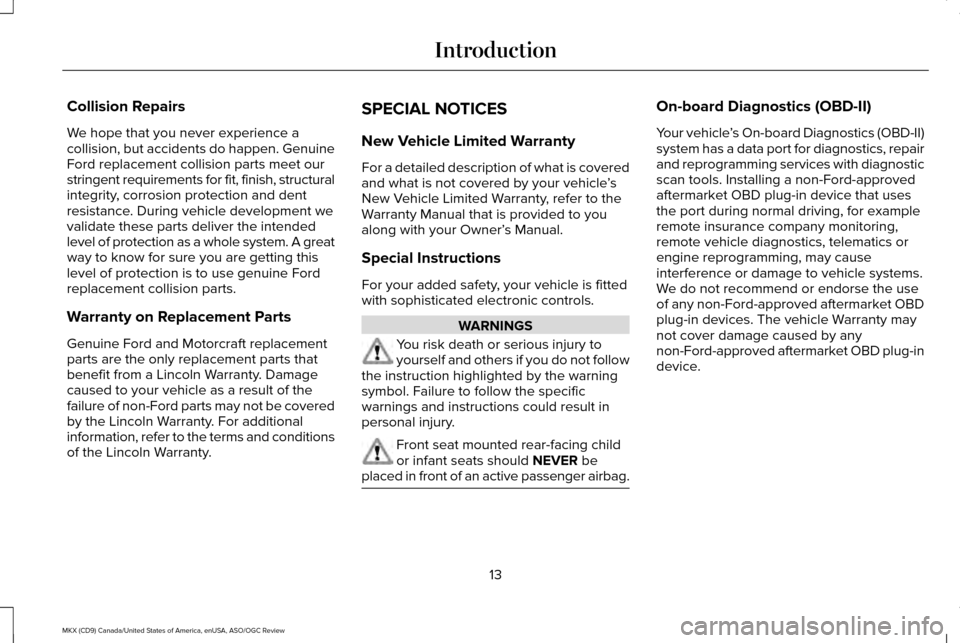
Collision Repairs
We hope that you never experience a
collision, but accidents do happen. Genuine
Ford replacement collision parts meet our
stringent requirements for fit, finish, structural
integrity, corrosion protection and dent
resistance. During vehicle development we
validate these parts deliver the intended
level of protection as a whole system. A great
way to know for sure you are getting this
level of protection is to use genuine Ford
replacement collision parts.
Warranty on Replacement Parts
Genuine Ford and Motorcraft replacement
parts are the only replacement parts that
benefit from a Lincoln Warranty. Damage
caused to your vehicle as a result of the
failure of non-Ford parts may not be covered
by the Lincoln Warranty. For additional
information, refer to the terms and conditions
of the Lincoln Warranty.
SPECIAL NOTICES
New Vehicle Limited Warranty
For a detailed description of what is covered
and what is not covered by your vehicle
’s
New Vehicle Limited Warranty, refer to the
Warranty Manual that is provided to you
along with your Owner’ s Manual.
Special Instructions
For your added safety, your vehicle is fitted
with sophisticated electronic controls. WARNINGS
You risk death or serious injury to
yourself and others if you do not follow
the instruction highlighted by the warning
symbol. Failure to follow the specific
warnings and instructions could result in
personal injury. Front seat mounted rear-facing child
or infant seats should NEVER be
placed in front of an active passenger airbag. On-board Diagnostics (OBD-II)
Your vehicle
’s On-board Diagnostics (OBD-II)
system has a data port for diagnostics, repair
and reprogramming services with diagnostic
scan tools. Installing a non-Ford-approved
aftermarket OBD plug-in device that uses
the port during normal driving, for example
remote insurance company monitoring,
remote vehicle diagnostics, telematics or
engine reprogramming, may cause
interference or damage to vehicle systems.
We do not recommend or endorse the use
of any non-Ford-approved aftermarket OBD
plug-in devices. The vehicle Warranty may
not cover damage caused by any
non-Ford-approved aftermarket OBD plug-in
device.
13
MKX (CD9) Canada/United States of America, enUSA, ASO/OGC Review Introduction
Page 21 of 563
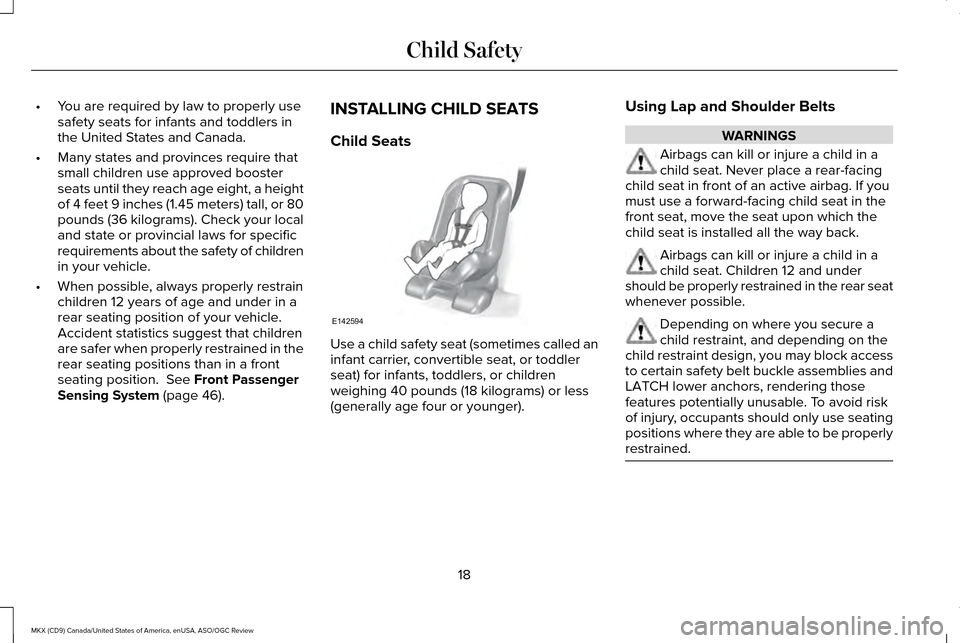
•
You are required by law to properly use
safety seats for infants and toddlers in
the United States and Canada.
• Many states and provinces require that
small children use approved booster
seats until they reach age eight, a height
of 4 feet 9 inches (1.45 meters) tall, or 80
pounds (36 kilograms). Check your local
and state or provincial laws for specific
requirements about the safety of children
in your vehicle.
• When possible, always properly restrain
children 12 years of age and under in a
rear seating position of your vehicle.
Accident statistics suggest that children
are safer when properly restrained in the
rear seating positions than in a front
seating position. See Front Passenger
Sensing System (page 46). INSTALLING CHILD SEATS
Child Seats
Use a child safety seat (sometimes called an
infant carrier, convertible seat, or toddler
seat) for infants, toddlers, or children
weighing 40 pounds (18 kilograms) or less
(generally age four or younger).Using Lap and Shoulder Belts WARNINGS
Airbags can kill or injure a child in a
child seat. Never place a rear-facing
child seat in front of an active airbag. If you
must use a forward-facing child seat in the
front seat, move the seat upon which the
child seat is installed all the way back. Airbags can kill or injure a child in a
child seat. Children 12 and under
should be properly restrained in the rear seat
whenever possible. Depending on where you secure a
child restraint, and depending on the
child restraint design, you may block access
to certain safety belt buckle assemblies and
LATCH lower anchors, rendering those
features potentially unusable. To avoid risk
of injury, occupants should only use seating
positions where they are able to be properly
restrained. 18
MKX (CD9) Canada/United States of America, enUSA, ASO/OGC Review Child SafetyE142594
Page 23 of 563
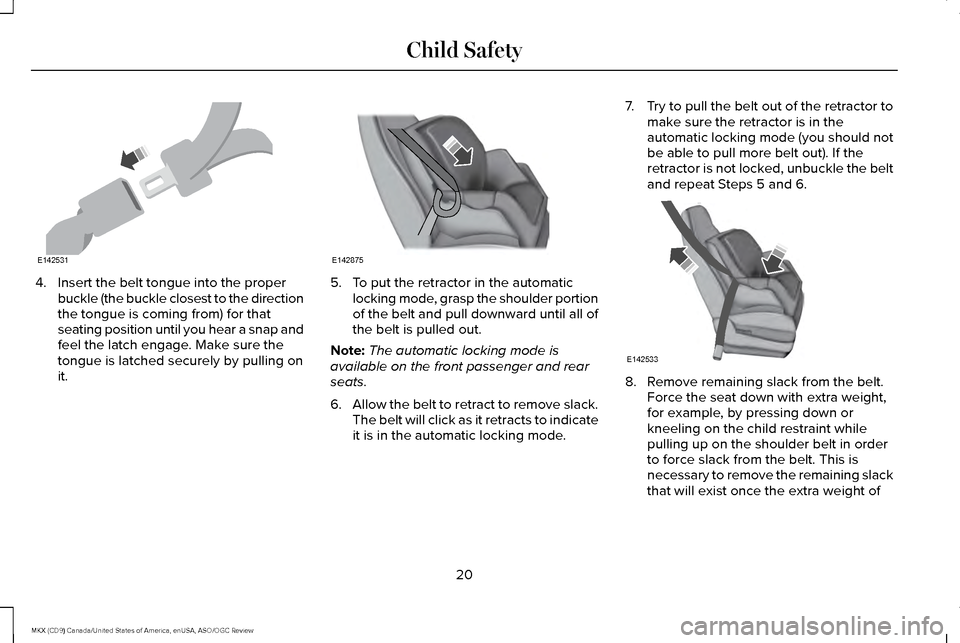
4. Insert the belt tongue into the proper
buckle (the buckle closest to the direction
the tongue is coming from) for that
seating position until you hear a snap and
feel the latch engage. Make sure the
tongue is latched securely by pulling on
it. 5. To put the retractor in the automatic
locking mode, grasp the shoulder portion
of the belt and pull downward until all of
the belt is pulled out.
Note: The automatic locking mode is
available on the front passenger and rear
seats.
6. Allow the belt to retract to remove slack.
The belt will click as it retracts to indicate
it is in the automatic locking mode. 7.
Try to pull the belt out of the retractor to
make sure the retractor is in the
automatic locking mode (you should not
be able to pull more belt out). If the
retractor is not locked, unbuckle the belt
and repeat Steps 5 and 6. 8. Remove remaining slack from the belt.
Force the seat down with extra weight,
for example, by pressing down or
kneeling on the child restraint while
pulling up on the shoulder belt in order
to force slack from the belt. This is
necessary to remove the remaining slack
that will exist once the extra weight of
20
MKX (CD9) Canada/United States of America, enUSA, ASO/OGC Review Child SafetyE142531 E142875 E142533
Page 25 of 563
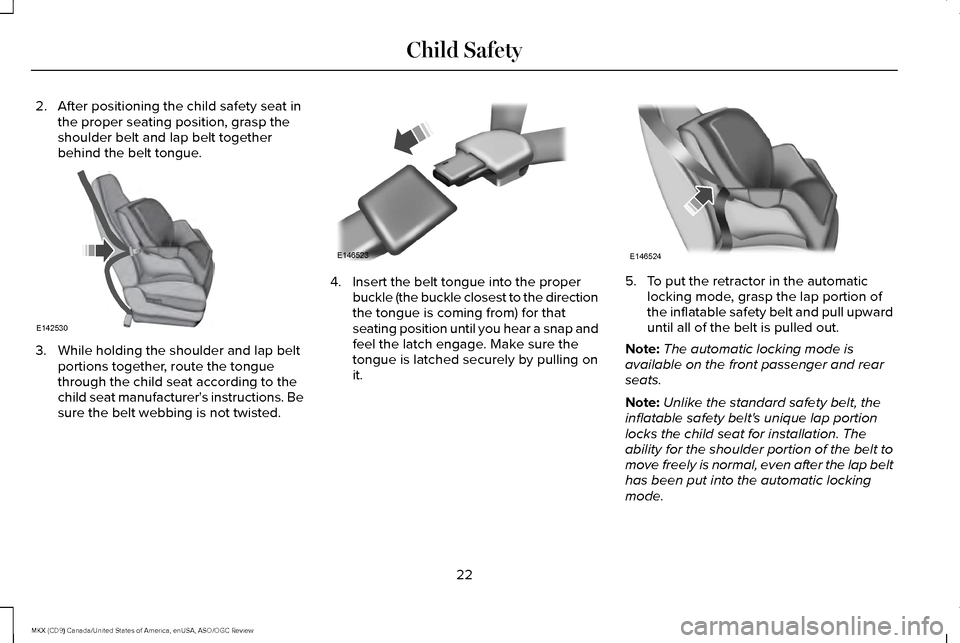
2. After positioning the child safety seat in
the proper seating position, grasp the
shoulder belt and lap belt together
behind the belt tongue. 3. While holding the shoulder and lap belt
portions together, route the tongue
through the child seat according to the
child seat manufacturer's instructions. Be
sure the belt webbing is not twisted. 4. Insert the belt tongue into the proper
buckle (the buckle closest to the direction
the tongue is coming from) for that
seating position until you hear a snap and
feel the latch engage. Make sure the
tongue is latched securely by pulling on
it. 5. To put the retractor in the automatic
locking mode, grasp the lap portion of
the inflatable safety belt and pull upward
until all of the belt is pulled out.
Note: The automatic locking mode is
available on the front passenger and rear
seats.
Note: Unlike the standard safety belt, the
inflatable safety belt's unique lap portion
locks the child seat for installation. The
ability for the shoulder portion of the belt to
move freely is normal, even after the lap belt
has been put into the automatic locking
mode.
22
MKX (CD9) Canada/United States of America, enUSA, ASO/OGC Review Child SafetyE142530 E146523 E146524
Page 29 of 563
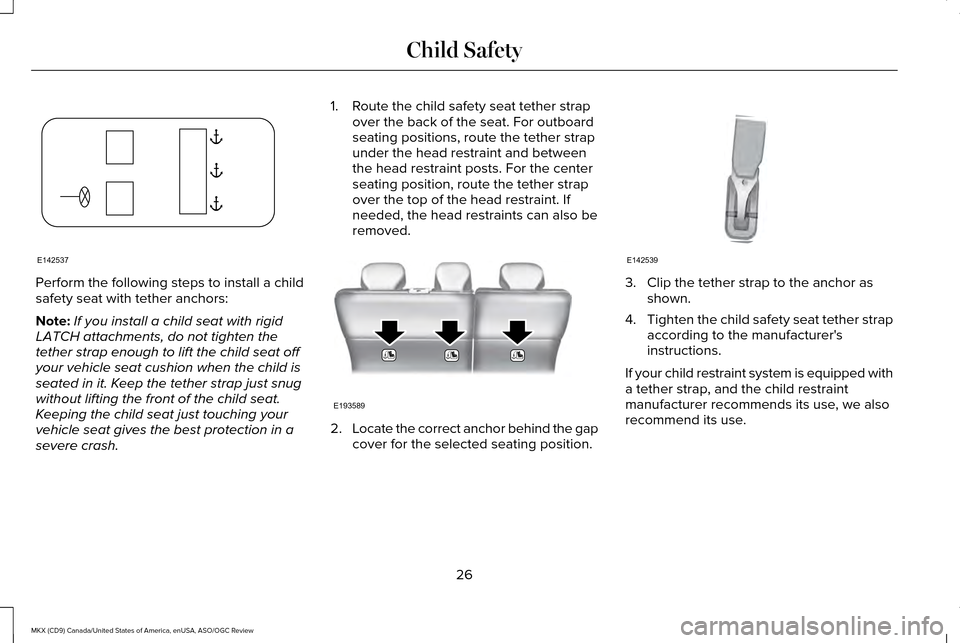
Perform the following steps to install a child
safety seat with tether anchors:
Note:
If you install a child seat with rigid
LATCH attachments, do not tighten the
tether strap enough to lift the child seat off
your vehicle seat cushion when the child is
seated in it. Keep the tether strap just snug
without lifting the front of the child seat.
Keeping the child seat just touching your
vehicle seat gives the best protection in a
severe crash. 1. Route the child safety seat tether strap
over the back of the seat. For outboard
seating positions, route the tether strap
under the head restraint and between
the head restraint posts. For the center
seating position, route the tether strap
over the top of the head restraint. If
needed, the head restraints can also be
removed. 2.
Locate the correct anchor behind the gap
cover for the selected seating position. 3. Clip the tether strap to the anchor as
shown.
4. Tighten the child safety seat tether strap
according to the manufacturer's
instructions.
If your child restraint system is equipped with
a tether strap, and the child restraint
manufacturer recommends its use, we also
recommend its use.
26
MKX (CD9) Canada/United States of America, enUSA, ASO/OGC Review Child SafetyE142537 E193589 E142539
Page 32 of 563
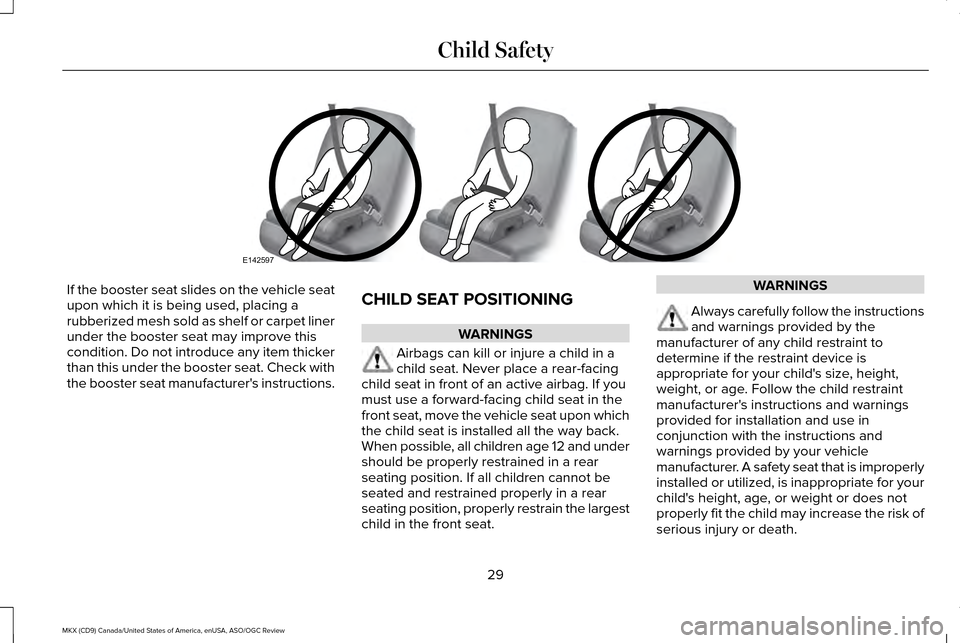
If the booster seat slides on the vehicle seat
upon which it is being used, placing a
rubberized mesh sold as shelf or carpet liner
under the booster seat may improve this
condition. Do not introduce any item thicker
than this under the booster seat. Check with
the booster seat manufacturer's instructions.
CHILD SEAT POSITIONING WARNINGS
Airbags can kill or injure a child in a
child seat. Never place a rear-facing
child seat in front of an active airbag. If you
must use a forward-facing child seat in the
front seat, move the vehicle seat upon which
the child seat is installed all the way back.
When possible, all children age 12 and under
should be properly restrained in a rear
seating position. If all children cannot be
seated and restrained properly in a rear
seating position, properly restrain the largest
child in the front seat. WARNINGS
Always carefully follow the instructions
and warnings provided by the
manufacturer of any child restraint to
determine if the restraint device is
appropriate for your child's size, height,
weight, or age. Follow the child restraint
manufacturer's instructions and warnings
provided for installation and use in
conjunction with the instructions and
warnings provided by your vehicle
manufacturer. A safety seat that is improperly
installed or utilized, is inappropriate for your
child's height, age, or weight or does not
properly fit the child may increase the risk of
serious injury or death.
29
MKX (CD9) Canada/United States of America, enUSA, ASO/OGC Review Child SafetyE142597